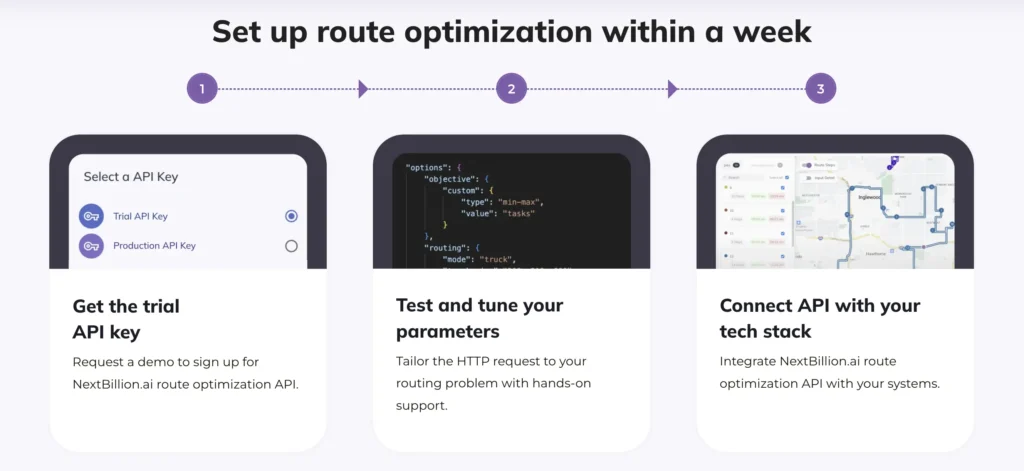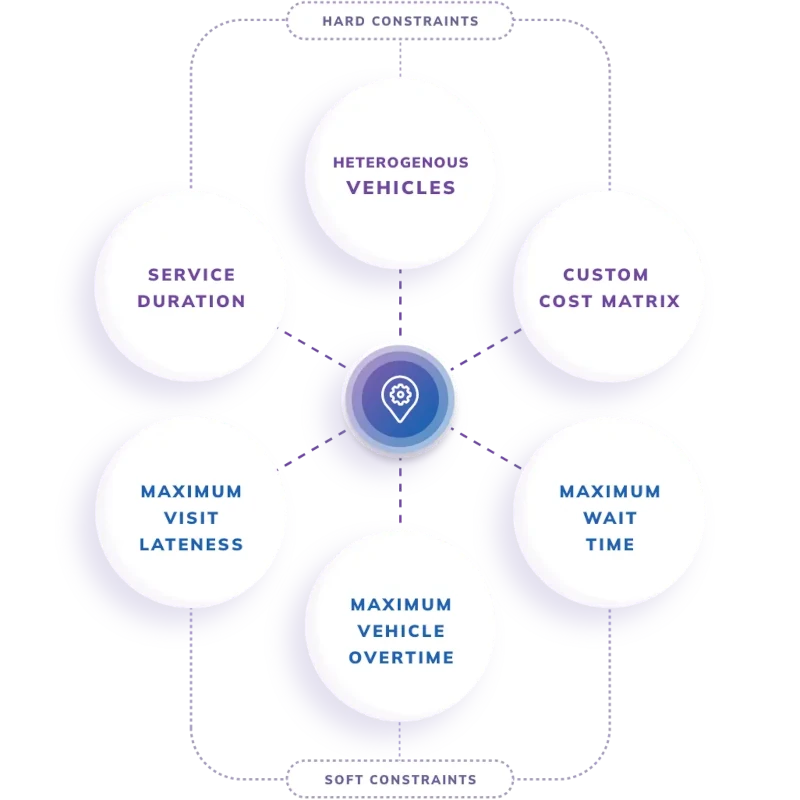Table of Contents
Efficient fleet management in the oil and gas industry is critical in the ever-evolving business landscape. With heavy volumes of product in transit, it is crucial for logistics and services to optimize fleet operations and help you maintain a competitive edge.
Modern fleet management relies heavily on data-driven strategies. These approaches enhance route planning, reduce fuel consumption, and bolster safety measures. Technological advancements, particularly in fleet management software, have streamlined these processes significantly.
Recent studies make it evident that optimized routing can cut fuel costs by up to twenty percent. This also means that you can run operations at reduced cost while witnessing a steady increase in ROI.
Read on to understand the nuances of fleet management and how critical route optimization is to the oil and gas industry.
Fleet Management in Oil and Gas
The oil and gas sector is a global economic powerhouse, generating approximately $5.3 trillion in worldwide revenue as of 2024. Its impact resonates through various sectors, including transportation, energy production, and manufacturing.
Fleet management per se involves coordinating a wide range of vehicles and equipment used for exploration, drilling, production, and distribution operations. This includes managing heavy-duty trucks, tankers, and specialized machinery such as fracking units and workover rigs.
Effective management of these oil and gas fleets ensures optimal utilization, mandatory equipment maintenance, regulatory compliance, and controlled operational costs.
Fleet management includes strategies for:
Tracking assets
Optimizing routes
Safety monitoring – for vehicles and drivers
Maintenance
Managing fuel
Effective fleet management practices enable you to not only enhance operational efficiency and minimize non-productive time, but also manage asset quality and boost rig uptime. This definitely leads to significant cost savings and improved overall performance.
How does Fleet Management work in Oil and Gas?
In a complex environment like oil and gas, managing assets and logistics at every tier is of utmost importance. You have to manage a vast and dispersed fleet of assets at any point in time with precision and speed.
As industry professionals understand, following best practices in fleet management is the only way to ensure operational efficiency, regulatory compliance and reduced cost.
Let’s take a look at how fleet management really works and what it encompasses.
1. Choose suitable vehicles
First step in the process of managing a fleet is to choose a perfect vehicle for the project. Post that, you need to assess conditions such as climate, the load and terrain. Based on the evaluation, organizing suitable vehicles for the specific nature of the job apart from the other equipment becomes easier.
In this step, it is quite critical to assign vehicles with the durability the project requires.
2. Plan and coordinate routes
This is by far the most complex in fleet management. With several trucks plying the roads to deliver to hundreds of destinations, coordinating, assigning, tracking and managing is beyond overwhelming.
This is where route optimization plays a pivotal role. Fleet managers create comprehensive schedules covering material transport, equipment upkeep, and shift coordination. Comprehensive route optimization software helps further in optimizing various fleet operations, including rig relocations, fracking activities, and product delivery.
These tools take into account various factors like traffic conditions, distance constraints, payload capacity of vehicles, terrain challenges, and regulatory requirements. By considering these elements, you can largely minimize travel time, fuel consumption, and operational costs for tasks like rig moves, fracking operations, and product transportation.
3. Map data in real-time
Tracking and monitoring fleets in real-time is an arduous task if done manually. You could lose track of movement and momentum when there are several vehicles to be monitored at the same time.
That’s where fleet management solutions come into action. They incorporate GPS tracking and telematics systems to monitor the real-time location, movement, and status of vehicles and equipment. This real-time data helps managers to track ongoing shipments, ensure that vehicles adhere to optimal routes, and respond swiftly to any issues or emergencies that arise.
By providing comprehensive, up-to-the-minute information, these systems enable more efficient and responsive fleet operations in the dynamic oil and gas industry.
4. Plan repairs and maintenance
Preventive maintenance can change your game in managing unplanned breakdowns. While you need to ensure regular vehicle and equipment maintenance, being prepared for the unexpected is important.
Effective fleet management strategies help you in scheduling routine checks and continuous monitoring of each vehicle and piece of equipment. By leveraging advanced telematics data, you can anticipate maintenance needs with accuracy, enabling you to take preventive action before issues escalate.
This data-driven approach to maintenance yields multiple benefits. First, it significantly reduces unexpected downtime, ensuring smooth operations and minimizing production losses. Second, it extends the operational life of valuable assets, maximizing return on investment. Finally, it enhances overall safety by reducing the risk of equipment failure in potentially hazardous environments.
5. Manage compliance and safety
Adhering to compliance requirements is mandatory in managing fleets in this industry. While you ensure compliance, prioritizing safety of drivers also takes precedence.
There’s no room for slack on safety or concerns regarding driver behavior.
Fleet management tools make this an easy task by tracking issues in drivers such as speeding, irresponsible driving, and harsh braking.
Comprehensive tracking helps in implementing corrective measures and targeted training programs to promote safe driving practices. As you know, the oil and gas industry operates under strict environmental, safety, and operational regulations. These tools help in monitoring and reporting various compliance metrics, including emissions, hours of service, and inspection records. This detailed oversight ensures adherence to regulatory requirements and supports you in maintaining compliance in a heavily regulated sector.
6. Monitor fuel consumption
One of the major costs in operating fleets is fuel. It is an inevitable and significant expense which can be managed efficiently using the fleet management tools. You can not only optimize but also reduce the overall operational costs largely.
With comprehensive fuel-efficient strategies which include route optimization to minimize travel distances, you can ensure proper tire pressure maintenance, and promote fuel-efficient driving techniques. By tracking fuel consumption, idling times, and driving behaviors, these systems help identify inefficiencies.
7. Analyze fleet data
Every industry thrives on quantifiable data, This helps in understanding trends, issues and ways to resolve specific concerns in your company.
Fleet data is immensely useful to understand routes, distances, drivers, and fuel consumption.
Fleet managers can use this data analysis from multiple sources to enhance operations, explore new opportunities, optimize route planning and allocate resources. You can make informed decisions on vehicle maintenance schedules and replacement timing.By tracking key performance metrics, you can quantify and showcase the value of fleet management initiatives. This data-driven strategy leads to more efficient, cost-effective, and productive fleet operations.
Fleet Management Challenges in the Oil and Gas Industry
It’s not an exaggeration when we say that fleet management in the oil and gas industry is a unique challenge. Transporting fragile and inflammable goods is definitely delicate and needs caution.
Here are some of the basic challenges that fleets face:
Infrastructure: The need for adequate infrastructure is of prime importance to facilitate the transportation of oil, gas, and other fuels. It is also important to plan strategies and protocols that effectively reduce the risks associated with spills, leaks, and road accidents.
Weather: This is unforeseen and not in our control. Yet, fleets need to be prepared for the worst of weather, rough terrains, and unfamiliar routes to ensure smooth operations.
Fuel: Operating costs, particularly fuel and maintenance expenses are quite a challenge. Since heavy vehicles are exposed to harsh environments, this adds to considerable stress on operational budgets.
Safety: An element that cannot be compromised, safety, is another huge challenge that fleet management faces. Apart from environmental and safety regulations, you also need to have permits, qualifications and inspections in place.
Coordination and tracking: While coordination with numerous drivers is a challenge, real-time tracking and monitoring of vehicles is mandatory to check on fuel consumption, distance and driver behavior.
Maintenance: Maintaining vehicles to always remain healthy is crucial for fleet management. Constant monitoring of vehicle health has to be a planned process to ensure no breakdowns.
Effective Oil and Gas Fleet Management with Route Optimization
Effective fleet management in the oil and gas industry aims to balance operational efficiency, cost reduction, safety, and environmental responsibility, ultimately supporting your overall business objectives.
One of the most important aspects in fleet management is route optimization. Large fleets, heavy loads, various distances, different drivers and gallons of fuel – all of this can be carefully managed just by optimizing the routes for the fleets.
What is Route Optimization?
Route optimization is a critical process in logistics that goes beyond finding the shortest and most cost-effective routes. It considers multiple factors such as delivery locations, time windows, and other constraints to determine the most efficient route.
In today’s competitive business environment, efficient logistics is crucial. Route optimization has emerged as a key solution, leveraging advanced algorithms and technology to revolutionize transportation planning and execution. Optimizing routes help you meet rising customer expectations while maximizing operational efficiency in supply chains.
Efficient route optimization can also help you lower carbon emissions and increase client satisfaction by delivering on time, every time.
Why is Route Optimization Important?
Planning, coordinating and tracking routes coupled with managing fuel for all the assigned vehicles is the most painstaking part of fleet management. The solution to handling this complex web is comprehensive route optimization.
Did you know that in many industries, driver wages and fuel costs alone sum up to 59.8% of the total operational cost per mile?
Every planned improvement to your fleet routes can help you deliver packages faster and have a major impact on your bottom line. With a comprehensive route optimization tool, you can save up to 20% in mileage and improve your order capacity by almost 100% without increasing your fleet.
Route optimization specially helps in the following:
Intelligent planning of multi-routes, thereby cutting fuel costs and travel time.
Prioritizing customer needs by customizing details such as preferred delivery time and handling special requests.
Maintaining vehicle efficiency by allocating the right vehicle for the right load.
Analyzing data that helps in improving operations and critical decisions.
Minimizing carbon footprint by drastically reducing drive time.
What to Look for in a Route Optimization Tool?
Route optimization, as we know, is almost the lifeline of seamless fleet operations in the oil and gas industry. Distances, loads, heavy-duty vehicles, fuel and drivers are all crucial elements of this process.
So what should you look for in a route optimization tool? What features should you pin your focus on?
Fleet management in complex logistics environments requires robust solutions. The perfect tool addresses this need by simplifying operations and boosting efficiency, despite strict regulations and challenging conditions.
Nextbillion’s Route Optimization API
Nexbillion’s Route Optimization API is your solution to complex fleet management concerns. A well-rounded tool, this API generates the best routes to maximize fleet utilization and fit your unique needs with over 50 hard and soft routing constraints, and custom objective functions like shortest distance, lowest cost or quickest ETA.
The Route Optimization API helps you optimize delivery routes and solve both Single and/or Multi-Vehicle Routing Problem (VRP). By allocating the best routes for fleets to cover various locations, this tool addresses various constraints such as time windows, capacity, and vehicle availability.
An experienced API tool can deliver all or more features that you need for your oil and gas business.
Let’s take a look at the features that make this API tool a solid preference for any business.
Precise route allocation
Routing algorithms enhance fleet efficiency by incorporating real-time traffic data, vehicle capacity limits, time constraints, and avoidance zones. This system skillfully manages operations for rig moves, fracking, and product transport by picking logical routes with task sequencing for delivery.
Precise routes are allocated for fleets to deliver at various locations, without covering unwanted miles. It ensures timely deliveries while reducing travel time, minimizing vehicle wear, and lowering fuel consumption. The result is a streamlined process that improves overall operational performance in challenging oil and gas logistics environments.
Easy API integration
Finding the right tool that integrates and communicates with other platforms seamlessly is a dream. This API is one such. You can embed this tool into your transport management system or integrate it with any other logistic applications easily. You can customize routes with over fifty constraints to suit your exact business requirements.
Track real-time
Real-time tracking gives you better control to oversee fleets of any size. It gives you clear visibility on every activity on an operational level. The system enables real-time monitoring of vehicles across various locations, including remote exploration and production sites. It tracks driver performance and provides instant route progress updates. With this, you can make informed decisions and have better control over operations, even in distant or challenging environments.
Simple dispatch process
This API streamlines the complex task of driver dispatch process and route management, particularly when dealing with unexpected changes. It offers one-click driver dispatch and flexible route modifications. It sends precise driving directions and delivery instructions directly ensuring clear communication and alignment across the team. This approach minimizes confusion, improves responsiveness to changing conditions, and enhances overall operational efficiency in dynamic logistics environments.
Crucial safety and compliance
In the oil and gas sector, adherence to safety protocols is paramount. This AI tool has strict adherence to all compliance regulations and safety protocols required for managing fleets across locations.
It supports regulatory compliance by enabling the collection of electronic signatures and photographic evidence for delivery confirmation. This digital approach simplifies record-keeping, helps in resolving disagreements, and facilitates adherence to hazardous materials handling regulations. By digitizing these crucial processes, the system helps companies maintain safety standards while improving operational efficiency.
Meticulous analytics
This API offers comprehensive analytical tools and reporting features that allow for monitoring of driver efficiency, route effectiveness, and delivery timing. By leveraging these data-driven insights, you can continuously refine operations, leading to improved performance and reduced costs. This analytical approach enables you to make critical decisions and supports ongoing optimization efforts across the logistics chain.
Benefits that scale your business
Route optimization is critical for fleets in the oil and gas industry, as much as it is for others too. This industry requires meticulous planning that ensures smooth operation of numerous trucks carrying loads of fragile goods. From material handling, optimal and fastest route, skilled drivers, to reliable infrastructure, every aspect plays a role in executing fleet services efficiently.
Using a route optimization API can create a lasting impact on your business by increasing revenue per driver and reducing overall costs. This tool simplifies loads of data that was once managed as voluminous documents, into simple information that can be intelligently used for improving business.
The benefits of using a route optimization tool can transform your business process instantly.
Save time and money: The most immediate benefits of implementing a route optimization tool are to save time and money. You save time by scheduling faster routes and thereby save fuel costs.
Improve operational KPIs: You can reduce up to forty percent time in scheduling, save almost thirty percent on API costs and bring down operational costs up to thirty five percent. These data indicate a drastic reduction in costs that add to the operational value.
Increase revenue: Route optimization balances cost reduction with service quality and regulatory compliance. It enhances fleet utilization, allowing drivers to complete more orders or service calls. It also helps you maximize your fleet capabilities by ensuring that drivers complete more orders or service calls, and increasing your revenue and profits.
Improve customer satisfaction: Customer is king. All service providers aim to provide the best service that keeps the customers happy. This system employs real-time tracking and estimated time of arrival (ETA) updates, coupled with proactive communication via SMS and email before scheduled deliveries or services. By keeping all parties informed, it significantly reduces the likelihood of delays, missed deliveries, or the need to reschedule appointments. This approach enhances reliability and customer satisfaction while minimizing operational disruptions.
Effective employee retention: Once you use a comprehensive API tool for route optimization, you can distribute workloads fairly and efficiently. This helps in keeping the employees comfortable in their jobs and retain them for longer.
Quick risk planning: Risks are a part of any business and that’s even more in logistics. Last minute driver cancellations, route changes, and managing multiple destinations are all inevitable. Dynamic planning with instant and automatic recalculation of routes to reflect real-time changes is crucial.
Transform your business with Route Optimization
Route optimization is undoubtedly a necessity for managing fleets in the oil and gas industry. It’s essential to understand the nuances of this tool that ultimately helps in your business growth.
The use of route optimization is proven to help businesses like yours cut planning time by up to 80% and save largely on operational costs such as driver wages and fuel cost. There’s no doubt that you can transform your business into a thriving corporation by deploying route optimization.
Ready to get started?
Request a DemoTable of Contents











